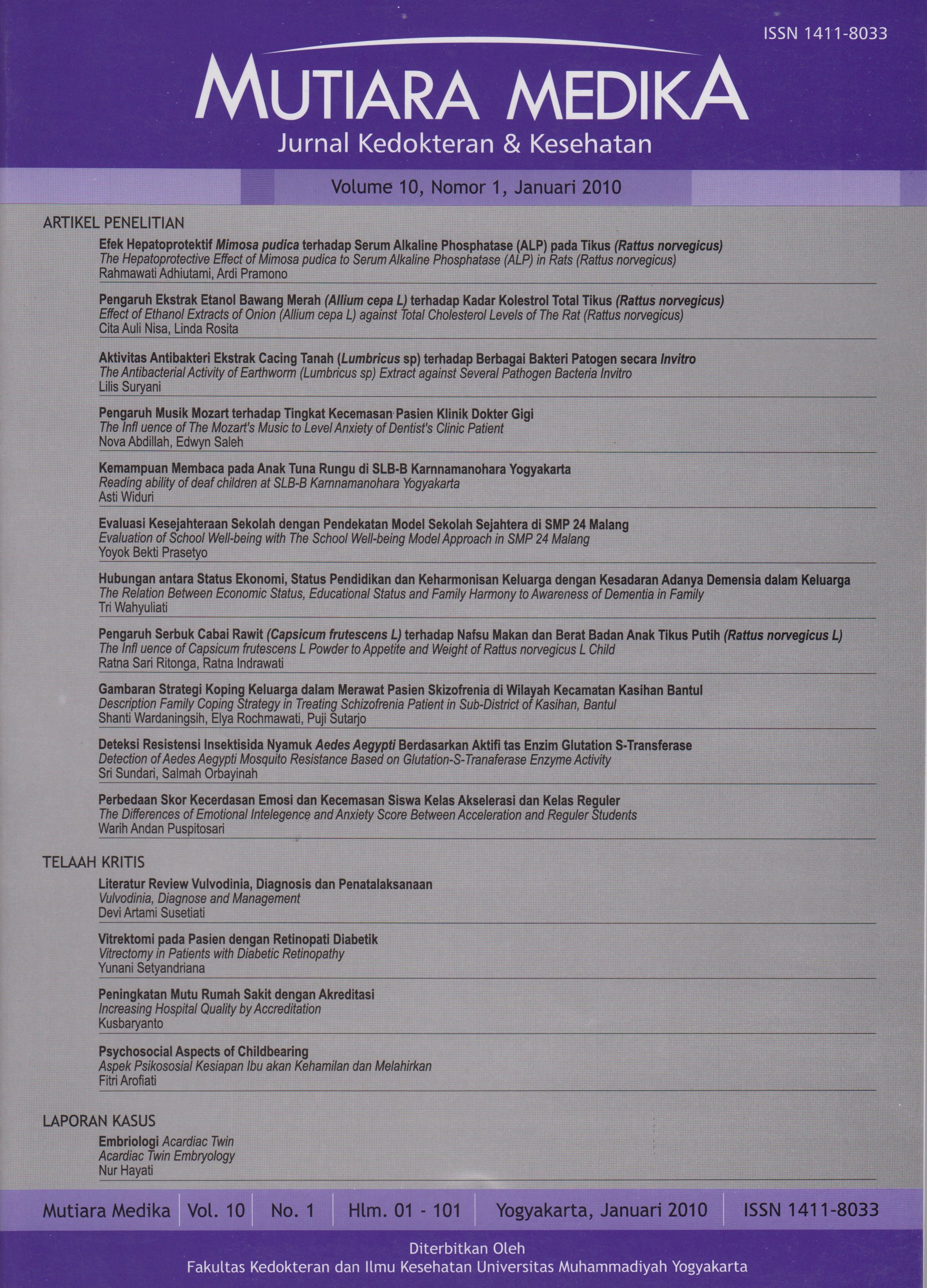Embriologi Acardiac Twin
DOI:
https://doi.org/10.18196/mmjkk.v10i1.1569Keywords:
acardiac twin, twin reversed-arterial-perfusion (TRAP), kembar monochorion, urutan embryologis, monochorionic twin, embryologic sequenceAbstract
Acardiac twin is a rare congenital malformation ofmonochorionic twin, often result from extensive abnormalplacental anastomose. This leads to twin reversed-arterial-perfusion (TRAP) syndrome in the recipient twin, causing hypoxia to the cephalic pole leading to abnormalities of the upper body. This condition is always fatalfor the recipient twin and carries a high mortality for the pump twin. Purpose of this article is to review the embryology of acardiac twin. Case reported a 25 years old secundigravida was referred to Tirtonegoro Hospital, Klaten at 30 weeks of gestation with ultrasound report performed by an obstetrician as a single pregnancy with intraabdominal cystic mass. At 33 weeks of gestation the patient was labour a twin. The first was spontaneous, vertex presentation, female, 1600g without any external malformation and no sign for cardiomegaly. The second, by cesarean delivery, female, acardiac-anceps, stillborn, 1950g. Monoplacenta, diamnionic and monochorionic with second twin’s umbilical cord 3 cm. This acardiac twin was not diagnosed in antenatal care. The conclusion is a rare case of acardiac twin has been reported and discussed embryologically. Acardiac twin is resulting from extensive abnormal placental vascular anastomosis between twins in monochorionic multiple pregnancies. Knowing the embryologic sequence is important to understanding the mechanism of twin placentation due to this unique syndrome.
Acardiac twin adalah suatu bentuk malformasi kongenital langka pada kembar monochorion, akibat anastomosis ekstensif pada pembuluh darah plasenta, menyebabkan terjadinya twin reversed-arterial-perfusion (TRAP) syndrome pada kembar “resipien” yang mengakibatkan hipoksia pada kutup kepala fetus dan selanjutnya terjadi abnormalitas pada badan bagian atas. Keadaan ini fatal bagi kembar resipien dan menyebabkan tingginya mortalitas dan morbiditas bagi kembar donor. Tujuan penulisan makalah ini adalah untuk menelaah embriologi kasus acardiac twin. Dilaporkan kasus seorang sekundigravida umur 25 tahun dirujuk ke RSU Tirtonegoro Klaten, pada umur kehamilan 30 minggu, hasil USG janin tunggal dengan masa kistik di abdomen. Pada umur kehamilan 33 minggu pasien melahirkan bayi kembar. Bayi I lahir spontan, presentasi kepala, perempuan, BB 1600 g, tidak ada malformasi eksternal dan tidak ada tanda cardiomegali. Bayi kedua lahir secara sectio sesaria, perempuan, acardiac- anceps, lahir mati, BB 1950 g. Plasenta monoplasenta, diamnion, monochorion dengan tali pusat janin II hanya 3 cm. Acardiac twin kasus ini tidak terdiagnosis pada saat ANC. Disimpulkan bahwa kasus yang jarang yaitu acardiac twin dan dibahas aspek embriologisnya. Acardiac twin terjadi karena adanya anastomosis abnormal pembuluh darah placenta pada kehamilan kembar monochorion. Memahami urutan embriologis penting untuk mengetahui mekanisme pembentukan plasenta yang berperan dalam kasus unik ini.
References
Rohilla M., Chopra S., Suri V., Anggarwal N., Vermani N. 2008. Acardiac- Acephalus Twins: A report of 2 Cases and Review of Literature. Medscape J Med. 10 (8):200
Hanafy A., Peterson C.M. 1997. Twin- reversed arterial perfusion (TRAP) sequence: case reports and review of literature. Aust N Z J Obstet Gynaecol. 1997; 37:187-191
Moore T.R., Gale S., Benirschke K. 1990. Perinatal outcome of forty-nine pregnancies complicated by acardiac twinning. Am J Obstet Gynaecol. 1990;163:907-912
Filly R.A., Goldstein R.B., Callen P.W. 1990. Monochorionic twinning: sonographic assessment. AJR. 154:459¬469
Dalton M.E., Newton E.R., Cetrulo C.L. 1984. Intrauterine fetal demise in multiple gestation. Acta Genet Med Gemellol (Aoma). 33:43-49
Moore K.L. 1988. The developing human: clinically oriented embryology, 4th ed. Philadelphia: Saunders.
Perveen S., Quddusi H., Faiz S.A.. 2008. Twin reversed arterial perfusion sequence/sequence acephalus acardiac fetus. Pak J Med Sci. 24(6):869-71
Wu C.J., Ding D.C., Ren S.S., Chang C.C., Weng J.T., Hwang K.S. 2008. Prenatal diagnosis and management of twin reversed arterial perfusion (TRAP) syndrome. Taiwan J Obstet Gynecol. 47:1
Downloads
Published
Issue
Section
License
Copyright
Authors retain copyright and grant Mutiara Medika: Jurnal Kedokteran dan Kesehatan (MMJKK) the right of first publication with the work simultaneously licensed under an Attribution 4.0 International (CC BY 4.0) that allows others to remix, adapt and build upon the work with an acknowledgment of the work's authorship and of the initial publication in Mutiara Medika: Jurnal Kedokteran dan Kesehatan (MMJKK).
Authors are permitted to copy and redistribute the journal's published version of the work (e.g., post it to an institutional repository or publish it in a book), with an acknowledgment of its initial publication in Mutiara Medika: Jurnal Kedokteran dan Kesehatan (MMJKK).
License
Articles published in the Mutiara Medika: Jurnal Kedokteran dan Kesehatan (MMJKK) are licensed under an Attribution 4.0 International (CC BY 4.0) license. You are free to:
- Share — copy and redistribute the material in any medium or format.
- Adapt — remix, transform, and build upon the material for any purpose, even commercially.
This license is acceptable for Free Cultural Works. The licensor cannot revoke these freedoms as long as you follow the license terms. Under the following terms:
Attribution — You must give appropriate credit, provide a link to the license, and indicate if changes were made. You may do so in any reasonable manner, but not in any way that suggests the licensor endorses you or your use.
- No additional restrictions — You may not apply legal terms or technological measures that legally restrict others from doing anything the license permits.






